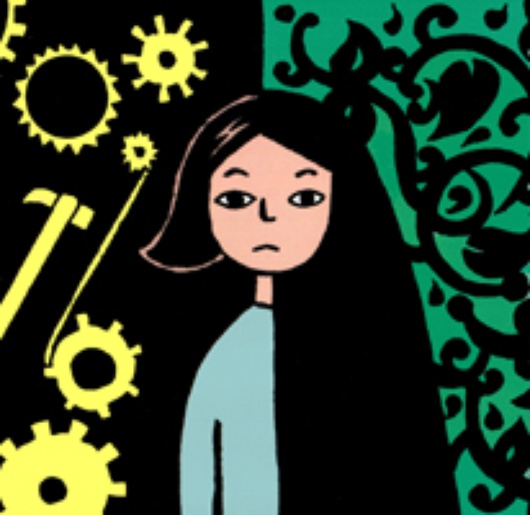Marjane Satrapi
Published on
Time to go ahead with the story of Persepolis. Here the part one.
Nat Marjane Satrapi – new literary phenomenon in comics
by Igor Prassel, part two
...
During the process of writing and drawing the story Marjane relieved a great frustration: “… Since I moved to France in 1994, I have always told my friends stories about life in Iran.
When they show news on Iran on television I am always furious because what they show is not representative of my experience. For almost twenty years I have had to explain why being Iranian is not a bad thing…”, and then from the introduction to her book published in the United States: "The Shah stayed on the throne until 1979, the year he fled Iran to escape the revolution. Since then, this old and great civilization has been mentioned mostly in connection with fundamentalism, fanaticism and terrorism. As an Iranian who has lived more than half of my life in Iran, I
 know this image to be far from the truth. This is why writing Persepolis seemed of such major importance to me. I believe that an entire nation should not be judged by the wrongdoings of a few extremists. I also didn't want those Iranians who lost their lives in prisons defending freedom, who died in the war against Iraq, who suffered under repressive regimes, or who were forced to flee their families and homeland to be forgotten. One can forgive but one should never forget." The first volume of Persepolis, which came out in France in 2000 with a historical introduction by David B., became a great success immediately. It tells the history of Iran
as seen through the eyes of a nine-year-old girl who lived in great expectation through the Islamic Cultural Revolution of 1979. I had the good fortune of meeting Marjane in 2001 on the stage of the theatre of Angoulême at the award ceremony (with Stripburger we received the prize for the best self-produced comic and Marjane won the Alph-Art “coup de cœur”, prize for the first work) and I knew immediately that she was an intelligent warm person and, without becoming immodest, would go a long way in the world of comics.
The jury was particularly impressed by the correctness of tone and the authenticity of the sentiments contained in the Persepolis album. The sobriety of the black and white drawing reflects childlike sensibilities and brings out the imaginary that triumphs in the tragic fall of Iranian society under the dictatorship. Going beyond the historical context, it presents universal aspects. In the same year Persepolis I was awarded the Golden Lion prize by the Comic Strip Centre of Brussels. The second volume brought her the prize for the best scene sequences at the Angoulême 2002 festival. It is not only the awards that testify to the work of Marjane Satrapi however. The third and fourth parts of Persepolis were published in a series in the important French daily newspaper Libération and the important American publishers, Pantheon Books, has published Persepolis 1 and 2 in English in hard cover format. Another source of satisfaction for the author is meeting her public, not a typical public of avid comic readers, but an indistinct public that prefers ‘serious’ reading material.
know this image to be far from the truth. This is why writing Persepolis seemed of such major importance to me. I believe that an entire nation should not be judged by the wrongdoings of a few extremists. I also didn't want those Iranians who lost their lives in prisons defending freedom, who died in the war against Iraq, who suffered under repressive regimes, or who were forced to flee their families and homeland to be forgotten. One can forgive but one should never forget." The first volume of Persepolis, which came out in France in 2000 with a historical introduction by David B., became a great success immediately. It tells the history of Iran
as seen through the eyes of a nine-year-old girl who lived in great expectation through the Islamic Cultural Revolution of 1979. I had the good fortune of meeting Marjane in 2001 on the stage of the theatre of Angoulême at the award ceremony (with Stripburger we received the prize for the best self-produced comic and Marjane won the Alph-Art “coup de cœur”, prize for the first work) and I knew immediately that she was an intelligent warm person and, without becoming immodest, would go a long way in the world of comics.
The jury was particularly impressed by the correctness of tone and the authenticity of the sentiments contained in the Persepolis album. The sobriety of the black and white drawing reflects childlike sensibilities and brings out the imaginary that triumphs in the tragic fall of Iranian society under the dictatorship. Going beyond the historical context, it presents universal aspects. In the same year Persepolis I was awarded the Golden Lion prize by the Comic Strip Centre of Brussels. The second volume brought her the prize for the best scene sequences at the Angoulême 2002 festival. It is not only the awards that testify to the work of Marjane Satrapi however. The third and fourth parts of Persepolis were published in a series in the important French daily newspaper Libération and the important American publishers, Pantheon Books, has published Persepolis 1 and 2 in English in hard cover format. Another source of satisfaction for the author is meeting her public, not a typical public of avid comic readers, but an indistinct public that prefers ‘serious’ reading material.
To be continued...
Credits
"Il velo di Maya o dell'ironia dell'Iran", Elettra Stamboulis e Gianluca Costantini, MIRADA cultural association, Ravenna, 2003.
Igor Prassel is member of Stripburger, Slovenian magazine of culture and comics.



